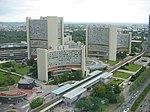The International Atomic Energy Agency (IAEA) is an intergovernmental organization that seeks to promote the peaceful use of nuclear energy and to inhibit its use for any military purpose, including nuclear weapons. It was established in 1957 as an autonomous organization within the United Nations system; though governed by its own founding treaty, the organization reports to both the General Assembly and the Security Council of the United Nations, and is headquartered at the UN Office at Vienna, Austria.
The IAEA was created in response to growing international concern toward nuclear weapons, especially amid rising tensions between the foremost nuclear powers, the United States and the Soviet Union. U.S. President Dwight D. Eisenhower's "Atoms for Peace" speech, which called for the creation of an international organization to monitor the global proliferation of nuclear resources and technology, is credited with catalyzing the formation of the IAEA, whose treaty came into force on 29 July 1957 upon U.S. ratification.
The IAEA serves as an intergovernmental forum for scientific and technical cooperation on the peaceful use of nuclear technology and nuclear power worldwide. It maintains several programs that encourage the development of peaceful applications of nuclear energy, science, and technology; provide international safeguards against misuse of nuclear technology and nuclear materials; and promote and implement nuclear safety (including radiation protection) and nuclear security standards. The organization also conducts research in nuclear science and provides technical support and training in nuclear technology to countries worldwide, particularly in the developing world.Following the ratification of the Treaty on the Non-Proliferation of Nuclear Weapons in 1968, all non-nuclear powers are required to negotiate a safeguards agreement with the IAEA, which is given the authority to monitor nuclear programs and to inspect nuclear facilities. In 2005, the IAEA and its administrative head, Director General Mohamed ElBaradei, were awarded the Nobel Peace Prize "for their efforts to prevent nuclear energy from being used for military purposes and to ensure that nuclear energy for peaceful purposes is used in the safest possible way".












